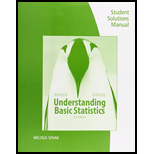
For each hypothesis test in Problems 3-10, please provide the following information:
What is the level of significance? State the null and alternate hypotheses.
Check Requirements What sampling distribution will you use? What assumptions are you making? What is the value of the sample test statistic?
Find (or estimate) the P-value. Sketch the sampling distribution and show the area corresponding to the P-value.
Based on your answers in parts (i)—(iii), will you reject or fail to reject the null hypothesis? Are the data statistically significant at level
Interpret your conclusion in the context of the application.
Note: For degrees of freedom d.f. not in the Student's t table, use the closest d.f that is smaller. In some cases, this choice will increase the P-value by a small amount or increase the length of a confidence interval, thereby making the answer slightly more “conservative." Answers may vary due to rounding.
Survey Response Validity The book Survey Responses: An Evaluation of Their Validity, by E. J. Wentland and K. Smith (Academic Press), includes studies reporting the accuracy of answers to questions from surveys. A study by Locander and others considered the question. "Are you a registered voter?” Accuracy of response was confirmed by a check of city voting records. Two methods of survey were used: a face-to-face interview and a telephone interview. A random sample of 93 people were asked the voter registration question face-to-face. Seventy-nine respondents gave accurate answers (as verified by city records). Another random sample of 83 people were asked the same question during a telephone interview. Seventy-four respondents gave accurate answers. Assume that the samples are representative of the general population.
Let
Does the interval contain numbers that are all positive? All negative? Mixed? Comment on the meaning of the confidence interval in the context of this problem. At the 95% level, do you detect any difference in the proportion of accurate responses from face-to-face interview's compared with the proportion of accurate responses from telephone interviews?
Test the claim that there is a difference in the proportion of accurate responses from face-to-face interviews compared with telephone interviews. Use
Trending nowThis is a popular solution!

Chapter 10 Solutions
Student Solutions Manual for Brase/Brase's Understanding Basic Statistics, 7th
- Should you be confident in applying your regression equation to estimate the heart rate of a python at 35°C? Why or why not?arrow_forwardGiven your fitted regression line, what would be the residual for snake #5 (10 C)?arrow_forwardCalculate the 95% confidence interval around your estimate of r using Fisher’s z-transformation. In your final answer, make sure to back-transform to the original units.arrow_forward
- BUSINESS DISCUSSarrow_forwardA researcher wishes to estimate, with 90% confidence, the population proportion of adults who support labeling legislation for genetically modified organisms (GMOs). Her estimate must be accurate within 4% of the true proportion. (a) No preliminary estimate is available. Find the minimum sample size needed. (b) Find the minimum sample size needed, using a prior study that found that 65% of the respondents said they support labeling legislation for GMOs. (c) Compare the results from parts (a) and (b). ... (a) What is the minimum sample size needed assuming that no prior information is available? n = (Round up to the nearest whole number as needed.)arrow_forwardThe table available below shows the costs per mile (in cents) for a sample of automobiles. At a = 0.05, can you conclude that at least one mean cost per mile is different from the others? Click on the icon to view the data table. Let Hss, HMS, HLS, Hsuv and Hмy represent the mean costs per mile for small sedans, medium sedans, large sedans, SUV 4WDs, and minivans respectively. What are the hypotheses for this test? OA. Ho: Not all the means are equal. Ha Hss HMS HLS HSUV HMV B. Ho Hss HMS HLS HSUV = μMV Ha: Hss *HMS *HLS*HSUV * HMV C. Ho Hss HMS HLS HSUV =μMV = = H: Not all the means are equal. D. Ho Hss HMS HLS HSUV HMV Ha Hss HMS HLS =HSUV = HMVarrow_forward
 Glencoe Algebra 1, Student Edition, 9780079039897...AlgebraISBN:9780079039897Author:CarterPublisher:McGraw Hill
Glencoe Algebra 1, Student Edition, 9780079039897...AlgebraISBN:9780079039897Author:CarterPublisher:McGraw Hill College Algebra (MindTap Course List)AlgebraISBN:9781305652231Author:R. David Gustafson, Jeff HughesPublisher:Cengage Learning
College Algebra (MindTap Course List)AlgebraISBN:9781305652231Author:R. David Gustafson, Jeff HughesPublisher:Cengage Learning

